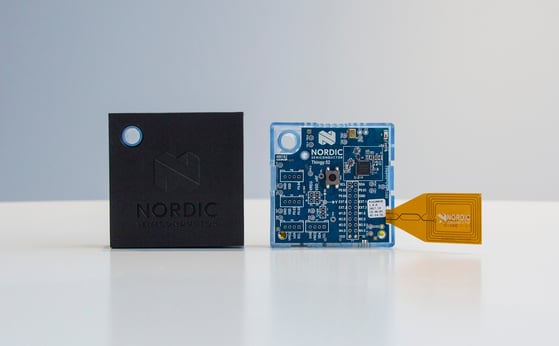Back to articles
Inside the Nordic Thingy

With more than 10,000 devices sold, Nordic Thingy:52 is a development kit helping developers and IoT entrepreneurs build the connected products of the future. Here is everything you need to know.
The Nordic Thingy:52 is an easy-to-use development platform, designed to quickly enable people who want to create IoT prototypes and demos without building hardware or writing firmware.
Visit our resource page on home and building automation
You can use it as an input device such as a doorbell, light switch, or to sense movement, temperature or even carbon dioxide. As an output device, you can make the built-in LED flash, sound an alarm, or even play music.
Nordic Thingy:52 is built around the nRF52832 Bluetooth® 5 SoC from Nordic Semiconductor. It connects to Bluetooth enabled mobile phones, laptops, tablets, Raspberry PIs etc. and sends data to/from its sensors and actuators to an app and to the cloud. The device itself is 6x6cm and comes in a plastic and rubber case.
![Thingy_hand.png[2]-095631-edited.jpg](https://blog.nordicsemi.com/hubfs/Blog_pics/Thingy/Thingy_hand.png%5B2%5D-095631-edited.jpg)
Power
The power button is located next to the standard micro-USB port. Nordic Thingy:52 has been designed with a focus on power efficiency and thanks to the Li-ion battery, it functions for extended periods of time without charging.
When you do need to charge the device, it connects to a computer or mobile charger via the micro-USB port. The power switch must be switched on in order for the device to charge.
Web API and mobile app
The functionality of the Nordic Thingy:52 can be configured over-the-air via a Bluetooth API. That makes it possible to create demos and prototypes without actually programming the Nordic Thingy:52 itself and do all development on the app or cloud solution.
As the device is in constant development, new features and bug fixes can be easily sent to the device over-the-air from the app. Advanced users can write their own firmware.
To get full value from the device, download the mobile app, currently available for iOS and Android. If you use a different smartphone or prefer not to install an app, there is a web application. When you switch on the Thingy, scan for the Eddystone beacon advertised by the Thingy and follow the URL.
> Read more: Introducing nearables: Personal portable beacons
Once you’re connected to the Thingy, the main screen on the app displays the environment sensor data. The menu lets you access the various other types of sensor data that the device can capture. Speaking of which…
Sensors, inputs & outputs
All sensors and Bluetooth low energy parameters are configurable through the Bluetooth API. Environmental sensors include temperature, humidity, pressure, air quality, colour and light. The device also features 9-axis motion sensing incorporating an accelerometer, gyroscope and compass.
The device also features a digital microphone and speaker for playing pre-stored samples and tones, or any sound you like that can be streamed over Bluetooth low energy (8-bit 8kHz LoFi). There is also a configurable RGB LED.
Connect to cloud services
While there is an impressive number of sensors, inputs and outputs for a device so small, the device can be extended further with a connection to the cloud.
Use your PC, iPhone or Android phone to connect your Thingy to nRF Cloud. From here, you can see all the data from the Thingy to verify the data connection is working and log data for further use.
The Thingy also works with If This Then That (IFTTT), a free way to connect a wide range of apps and devices. The possibilities are literally endless. If a Thingy senses a sudden change in temperature, an alert could be sent to an email account, Slack channel or via text message.
For more inspiration, check out this video where I took a walk around the Nordic Semiconductor offices to see how our engineers are using the product:


